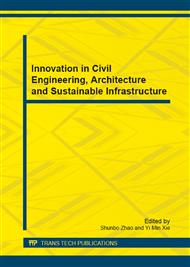[1]
East China Institute of Water Conservancy and Hydroelectric Power, C. Zhang, Hydraulic Engineering Design Manual, Water Resources and Electric Power Press, Beijing, (1984).
Google Scholar
[2]
Teaching and Research Section of River Sediment Engineering of Wuhan Institute of Hydraulic and Electric Engineering, J. Xie, River Sediment Engineering, Water Resources and Electric Power Press, Beijing, (1983).
Google Scholar
[3]
Y. Li, J. Yang, J. Zhang, Design of Sand Basin of Water Conservancy and Hydropower Projects, China Water Power Press, Beijing, (2004).
Google Scholar
[4]
W. H. Graf, E. R. Acaroglu, Settling Velocities of Natural Grains, Bulletin of the International Association of Scientific Hydrology, 4 (1966).
DOI: 10.1080/02626666609493492
Google Scholar
[5]
W. W. Rubey, Settling velocities of Gravel, Sand, and Silt Particles, American Journal of Science, 25 (1933) 325-338.
DOI: 10.2475/ajs.s5-25.148.325
Google Scholar
[6]
E. F. Schulz, R. H. Wilde, M. L. Albertson, Influence of Shape on the Fall Velocity of Sedimentary Particles, MRD Sediment Series, 5 (1954).
Google Scholar
[7]
W. L. Graf, Hydraulics of Sediment Transport, McGraw-Hill, New York, (1971).
Google Scholar
[8]
E. W. Lane, A. A. Kalinske, Engineering Calculations of Suspended Sediment, Transactions of the American Geophysical Union, (1941).
DOI: 10.1029/tr022i003p00603
Google Scholar
[9]
V. A. Vanoni, Transportation of Suspended Sediment by Water, Transactions of the ASCE, 111 (1946).
Google Scholar
[10]
D. B. Simons, F. Senturk, Sediment Transport Technology, Water Resources Publications, Fort Collins, Colorado, (1977).
Google Scholar
[11]
S. Goldstein, The Steady Flow of Viscous Fluid Past a Fixed Spherical Obstacle at Small Reynolds Number, Proceedings of the Royal Society of London, Series A, 123 (1929).
DOI: 10.1098/rspa.1929.0067
Google Scholar
[12]
H. Rouse, Fluid Mechanics for Hydraulic Engineers, chapter XI, Dover, New York, (1938).
Google Scholar
[13]
U. S. Bureau of Reclamation, Design of Small Dams, Denver, Colorado, (1987).
Google Scholar
[14]
V. A. Vanoni,. Sedimentation Engineering, ASCE Task Committee for the Preparation of the Manual on Sedimentation of the Sedimentation Committee of the Hydraulics Division, ed. 1975, Reprinted (1977).
DOI: 10.1061/jyceaj.0003982
Google Scholar
[15]
C. T. Yang, Incipient motion and Sediment Transport, Journal of the Hydraulics Division, ASCE, 99 (1973), HY10, Proceeding Paper 10067.
Google Scholar
[16]
Chih Ted Yang. Sediment Transport Theory and Practice.
Google Scholar


